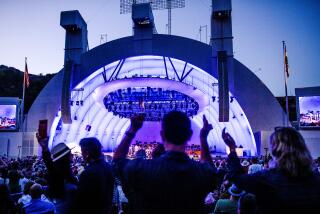Opinion: Here’s a New Year’s resolution worth keeping: Close Hollywood Boulevard to cars in 2016
Before it began crushing box-office records this month, “Star Wars: The Force Awakens” set a new record in Los Angeles when it shut down nearly half a mile of Hollywood Boulevard for five days for one of the largest movie premieres in Hollywood history.
The lengthy street closure came on the heels of the much-hyped debut of a pedestrian “scramble” at the intersection of Hollywood Boulevard and Highland Avenue. The newly designed intersection stops all traffic for a light cycle, allowing pedestrians to cross in any direction, reducing conflicts between pedestrians and turning drivers.
Scrambling is a safe, fun and smart policy. It undoubtedly made the life of everyone who attended the “Star Wars” premiere a whole lot easier that night. But as progressive as installing a scramble is in making Hollywood a more livable place, it’s only one step in a larger possible vision for Hollywood Boulevard -- one that has as much to do with “placemaking” as it does safety. One in which we can create an environment pleasant enough to actually want to spend time in the area, rather than one that most Angelenos avoid or begrudgingly shuffle through, at best.
Why don’t we make Hollywood Boulevard from Highland to Orange Drive car-free all the time?
The idea really isn’t that radical at all. A group of Hollywood residents have been asking Mayor Eric Garcetti to close the strip since 2014. This month alone, three back-to-back movie premieres, including “Star Wars,” closed Hollywood Boulevard for a week. Come February, the Oscars will return to shut down the stretch for even longer.
Traffic, like it has for decades, will be managed. The world won’t end.
When New York City famously banned vehicles from portions of Times Square in 2009, the dramatic need for increased pedestrian space and a reconfigured roadway was crystal clear. The 356,000 people who walked through Times Square each day spilled out onto Broadway and 7th Avenue, choosing to walk in moving traffic lanes to bypass slow-moving tourists. Street corners were so clogged with pedestrians that people jutted out into the street, further pinching and slowing traffic that was already averaging about 4.2 mph (seriously).
Like Times Square, Hollywood and Highland is one of the busiest intersections for pedestrians in its respective city. Though its numbers don’t compare with Times Square’s in overall volume, the intersection is packed. In 2013, the nonprofit Los Angeles Walks, where I work as policy manager, and our community partners counted a total of 14,510 people walking there over the course of three separate two-hour periods.
The intersection isn’t just crowded, it’s dangerous: the second-most-dangerous in Los Angeles to be exact. Between 2002 and 2013, drivers at Hollywood and Highland have hit 38 pedestrians; one was killed.
Though the Hollywood and Highland pedestrian scramble may help the area’s immediate safety concerns, it does nothing to account for future traffic growth on the area’s barely adequate sidewalk space. What L.A. and the throngs of visitors who come to the city urgently need is a better Hollywood destination -- a more comfortable and enjoyable public realm that will retain people beyond a brief moment of spectacle.
A car-free Walk of Fame will allow visitors to parade down the middle of Hollywood Boulevard, the star of their own production. It will encourage tourists to linger, passing leisurely among the Metro Red Line station, the Walk of Fame stars, the Chinese Theatre, restaurants, shops and museums, allowing them to more easily see and pursue whatever attracts them (and their wallets).
Two years after New York transformed Times Square into an inviting, human place, international real estate firm Cushman Wakefield placed it among the 10 most desirable retail locations on the planet, the first time in its history that Times Square made the list.
The constant road closures on Hollywood Boulevard have already proved that closing traffic from Highland Avenue to Orange Drive doesn’t grind the area to a screeching halt. Pedestrian counts and crash reports already show that people -- a lot of them -- are at risk when walking there. And studies make clear what a plaza in the area would likely bring: a decrease in motorist, passenger and pedestrian injuries, and an increase in pedestrian volumes and economic activity.
So what are we waiting for? Hollywood Boulevard did just fine when it was closed to traffic for much of this month. Let’s keep it that way. In 2016, let’s create a Walk of Fame worthy of the title -- a space that isn’t just safe, but one where people actually want to be.
Emilia Crotty is policy and program manager of Los Angeles Walks.
Follow the Opinion section on Twitter @latimesopinion and Facebook
More to Read
A cure for the common opinion
Get thought-provoking perspectives with our weekly newsletter.
You may occasionally receive promotional content from the Los Angeles Times.






